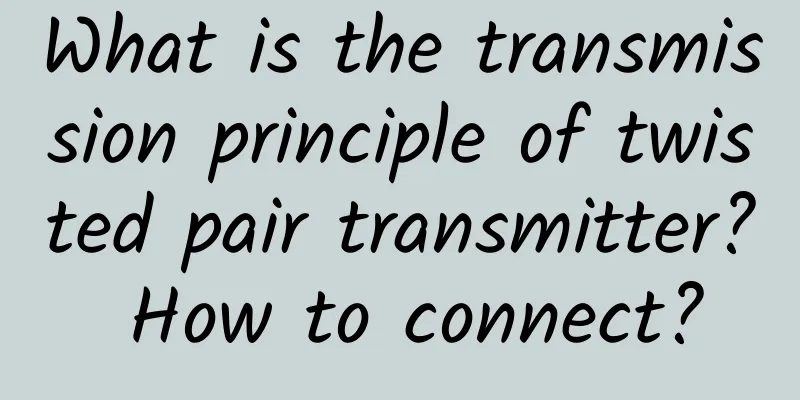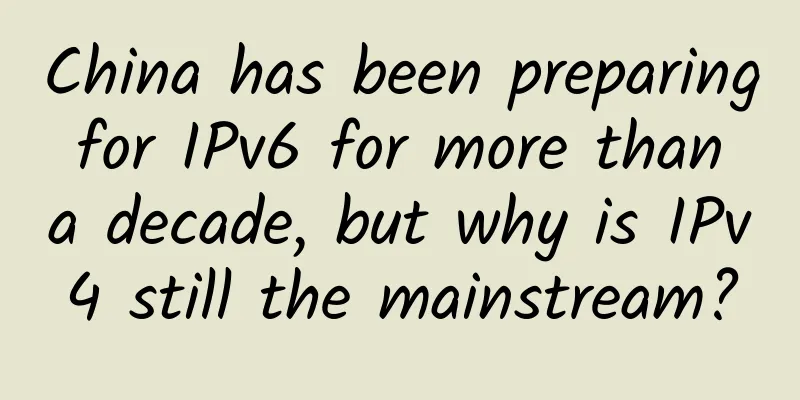What is the transmission principle of twisted pair transmitter? How to connect?

|
The usual video signal is an unbalanced video baseband signal, which is suitable for transmission in unbalanced transmission cables such as coaxial cables. Twisted pair cables are balanced transmission cables. Do you know how to connect a twisted pair transmitter? The following editor will introduce it to you. 1. Transmission principle of twisted pair transmitter The basic principle of using twisted pair to transmit video signals is: 1. The usual video signal is an unbalanced video baseband signal, which is suitable for transmission in unbalanced transmission cables such as coaxial cables. Twisted pair cables are balanced transmission cables. Due to the balanced transmission and twisted pair mode, twisted pair transmission has strong anti-interference ability. Therefore, to use twisted pair cables to transmit video signals, the video signals must be converted into balanced signals. 2. The video signal converted into balanced mode can be directly transmitted on the twisted pair cable, and is not easily affected by various interference signals. At the monitoring terminal, since the input ports of most monitoring equipment such as recording and display are unbalanced, the balanced signal transmitted by the twisted pair cable needs to be converted into an unbalanced signal. In other words, to use twisted pair cables instead of video cables to transmit video signals, you only need to add balanced/unbalanced converters (push-type terminals) at the front and rear ends of the cable. 3. The simplest converter is actually a video mutual inductance coil wound in parallel on a high magnetic flux and high bandwidth magnetic ring, which is often called a passive converter. It only plays the role of balanced/unbalanced conversion. It is a passive device and will not bring new distortion or generate noise, but it will attenuate the signal to a certain extent. 4. When the video signal is transmitted on a twisted pair, the attenuation of the signal, especially the attenuation of the high frequency component, is particularly serious. Therefore, the balanced video signal after being transmitted through the twisted pair must generally be amplified by an amplifier circuit, and the attenuation of the signal, especially the high frequency signal, must be enhanced and restored, and then converted into an unbalanced signal for use by monitors and other post-stage equipment. Usually this amplifier is called a twisted pair receiver, which plays the role of amplification and compensation. Generally, there are two adjustable potentiometers on it, which adjust the amplification gain of the entire amplifier and the compensation amount of the high frequency component according to the actual situation. 2. Wiring method of twisted pair transmitter Instructions for use of twisted pair transmitter: 1. As shown in the figure: This twisted pair transmitter is used in pairs, regardless of the transmitter and receiver. Connect a transmitter to the camera end and the host receiver. Connect the end of the transmitter with the BNC head to the video output end of the camera and the host end respectively, and then, after color-coding a pair of twisted pairs, connect them to the "+" and "-" terminals of the transmitter according to the positive and negative poles. When wiring, be sure to pay attention to the strict positive and negative poles of the twisted pair connected to the receiver and transmitter. 2. Only unshielded twisted pair cables (network cables) can be used. Advantages of using twisted pair transmitters: a. Reduce wiring costs. Traditional monitoring projects generally use SYV series coaxial cables (video cables) for wiring. One video cable can only transmit one signal at a time; while network cables can transmit four signals at the same time (the four pairs of twisted pairs in the network cable can be used at the same time, and the signals do not affect each other). Using twisted pair wiring increases wiring speed and greatly reduces wiring costs. b. Suitable for integrated wiring. One network cable has 4 twisted pairs, which can transmit 4 video images at the same time. One of the 4 twisted pairs transmits video signals, and the rest can also transmit audio signals, control signals, power supplies, etc., which improves the utilization rate of cables, reduces the trouble caused by separate wiring of various signals, reduces the disadvantages of coaxial cable wiring difficulties and occupying more pipeline resources, and makes the types of integrated wiring more unified. c. High anti-interference degree, clearer image. Twisted pair can effectively suppress common mode interference. Even in a strong interference environment, twisted pair can still transmit good image signals. Twisted pair can effectively suppress the interference in elevators, machine rooms, and various interferences in the surrounding environment. Selection of twisted pair cable (network cable) (key point): There is a huge difference in the image quality transmitted by a good network cable and a bad network cable, so you should choose carefully. A multimeter can be used to measure whether it is good or bad. A good network cable should have a single strand resistance of less than 1 ohm per 10 meters. Network cables on the market are generally 300 meters per box. When measuring this cable, the resistance of any one of the 4 pairs (8 in total) of twisted wires should be less than 30 ohms. Generally speaking, network cables with a resistance value of less than 40 ohms can be used. Although cables with a resistance value greater than this can be used, the transmission distance and effect will be greatly reduced. |
<<: What is AWG? Why is AWG an important parameter when choosing cables?
Recommend
Top 10 economic predictions for the tech industry in 2024
As we stand on the cusp of a new year, the tech i...
What is UTP Cable?
The Internet plays a key role in our daily lives,...
ENOs and Private LTE: Intelligent Connectivity for Smart Factories
Manufacturing processes and operations are underg...
If WeChat declines, who will replace it? Big guesses about the Internet in 2018
Where will the major domestic Internet companies ...
E-commerce past | Farewell to public domain traffic
[[420018]] It is not difficult to see that 2020 i...
Cisco Unleashes Unlimited Opportunities with Industry’s First Open, Intent-Based Networking Platform
The three major technological changes of the Inte...
Learn about the last of the four types of switch messages in one minute: known unicast
Continuing from the previous article "Learn ...
Quickly understand the characteristics and differences of HTTP1.0 1.1 2.0 3.0
HTTP1.0 HTTP version 1.0 is a stateless, connecti...
Linux common command find record
The tribe recorded some usage of the find command...
ZJI newly launched Hong Kong cluster server, 4C segment 238 IP monthly payment starts from 1400 yuan
This month, ZJI launched a new server cluster in ...
RAKsmart March Promotion: Popular VPS starting at $1.99/month, E3-1230 dedicated server only $30/month
RAKsmart has launched a promotional event for Mar...
OneTechCloud July promotion: VPS monthly payment 10% off/quarterly payment 20% off, Hong Kong CN2/CMI large bandwidth/US CN2 GIA/high defense optional
OneTechCloud (Yike Cloud) has started its July pr...
2017 is the turning point year with three main investment themes: 5G, Internet of Things and optical communications
[[179940]] In 2017, the capital expenditure of gl...
When WiFi6 collides with 5G, is it a crisis or a business opportunity?
September 16, 2019 WiFi Alliance announces WiFi6 ...









